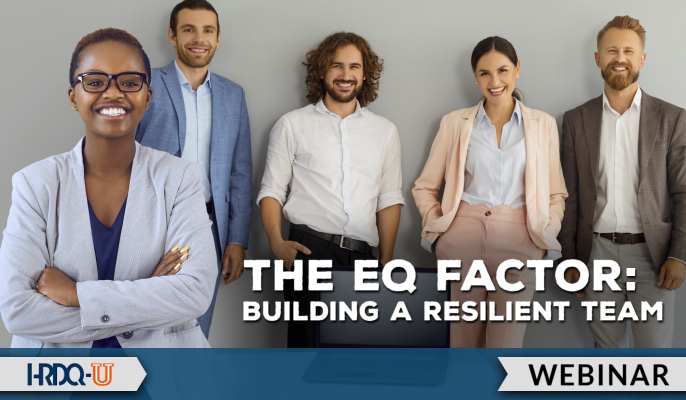- 827 Lincoln Ave. #B-10 West Chester, PA 19380
- support@hrdq.com
- +1-610-279-2002
Quick Links
Menu
Featured Topics
Menu
Total Results
We could not find what you're looking for. Please try again.No Record Found

The past two years have served as confirmation of the age-old adage: “Change is the only constant.” Amidst increasing ambiguity, shifting priorities, and overwhelming demands, industries have borne witness to the fact that a workforce that lacks resilience ceases to operate effectively if it manages to operate at all. Resilient teams can respond to uncertainty while maximizing performance and preserving stability. And it has a lot to do with building EQQ. Emotional quotient, or emotional intelligence, is the ability to identify one’s own emotions and those of others to manage and encourage effective responses.
There is a strong link between high EQ and resiliency; we know this from evidence in psychology, human development, and neuroscience. Borrowing from these fields of study, we’ll look at what building EQ looks like at the personal, team, and organizational levels; learn techniques to apply at each level to promote resiliency; and equip leaders with tools to successfully act as a conduit to advancing EQ and building adaptable, competent, and confident teams. Join this webinar to discover the impact of emotional intelligence on individuals, teams, and organizations. Learn techniques for building EQ and resiliency.


This course and assessment will significantly enhance communication skills for individuals and teams in your organization.
Use code: AlanaR10
Alana Ramey, MPA, is an educator, collaborator, and facilitator with a passion for effecting productive change in people and organizations. Her background in the public and social sectors provides her with a unique vantage point to the core of organizational effectiveness: the complex art of working with people. With an approach emphasizing 360° collaboration, innovative problem-solving, and engaging planning, implementation, and facilitation skills, she thrives on delivering outcomes to meet the emergent and changing needs of individuals, teams, and organizations of all sizes. Her career exemplifies a desire to partner at every level and across a range of differences to maximize sustainable growth and accomplish a unified goal.
Training Tools for Developing Great People Skills
This event is sponsored by HRDQ. For 45 years HRDQ has provided research-based, off-the-shelf soft-skills training resources for classroom, virtual, and online training. From assessments and workshops to experiential hands-on games, HRDQ helps organizations improve performance, increase job satisfaction, and more.
Learn more at HRDQstore.com
Discover more HRDQ-U emotional intelligence webinars
Access more valuable HRDQ-U content by Alana
Explore HRDQ Store’s emotional intelligence resources ⇗
Five signs of Workplace Resilience
AI and Emotional Intelligence Synergy: Five EQ Strategies Every Leader Should Implement
Why EQ is Important in the Age of Artificial Intelligence
The Optimistic Leader | Managing Stress and Building Resilience During Uncertain Times
The Synergy of AI and EQ: Five Emotional Intelligence Strategies Every Leader Should Implement
Workplace Redesign: 7 Strategies Leaders can Apply to Enhance EQ

Sign up to be notified of upcoming live webinars, in-depth workshops, podcasts, blog posts, promotions and much more. Stay ahead of the curve and subscribe for FREE today!